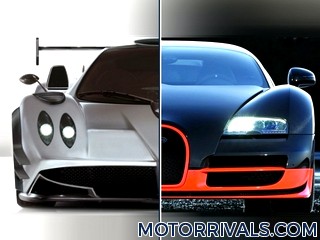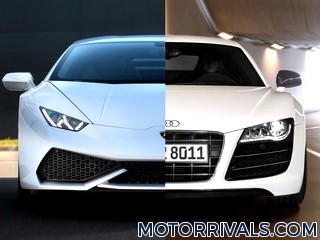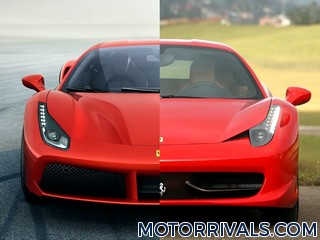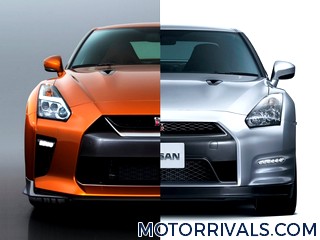2017 Lamborghini Aventador S vs 2016 McLaren 675LT
Lamborghini Press Release Highlights
The new Lamborghini Aventador S is characterized by new aerodynamic design, redeveloped suspension, increased power and new driving dynamics. The 'S' is the suffix of previous enhanced Lamborghini models and defines a new benchmark for the V12 Lamborghini. The design of the new Lamborghini Aventador S clearly indicates the new Aventador generation. The Aventador S features a number of exterior developments, particularly in front and rear, while its profile remains clearly an Aventador. Every modified component is redesigned for a purpose, achieving maximum aerodynamic efficiency while accenting the Aventador's complex, muscular dynamism. Furthermore, Lamborghini Centro Stile has intelligently integrated certain elements of past icons, such as the lines of rear wheel arches reminiscent of the original Countach.
The Lamborghini Aventador S design results in significantly enhanced aerodynamic performance. Front downforce has been improved by more than 130% over the previous Aventador coupé. When the wing is in its optimum position the overall efficiency at high downforce is improved by over 50%, and in low drag by more than 400% compared to the previous model.
A dry weight of just 1,575 kg provides a weight-to-power ratio of just 2.13 kg/hp. Acceleration from 0-100 km/h is reached in 2.9 seconds, with a top speed of 350 km/h. Transmission is provided by Lamborghini's lightweight Independent Shifting Rod (ISR) 7-speed shifting system, providing robotized gear shifts in up to 50 milliseconds.
The Aventador S adopts a new exhaust system developed as the result of a significant R&D project. More than 20% lighter than its predecessor and the product of testing multiple configurations, the results are an enhanced Lamborghini sound and resonance from the already inimitable V12 aspirated engine, with the three single pipe outlets at the rear of the Aventador S a visual reminder of the new exhaust system.
As in its predecessor, the Lamborghini Aventador S is equipped with a stop-and-start system and cylinder deactivation for optimized engine efficiency. When full engine capacity is not required, six of the twelve cylinders are temporarily deactivated by switching off one cylinder bank. When the driver accelerates, the system switches back instantaneously to twelve-cylinder mode, with the changeover virtually impossible to detect by the driver.
Enhanced lateral control comes from new four-wheel steering, which provides improved agility at low and medium speeds and more stability at high speed. On the front axle it is combined with Lamborghini Dynamic Steering (LDS), tuned for a more natural and responsive feel with a sharper turn-in. It is specially adapted to integrate with the active Lamborghini Rear-wheel Steering (LRS) on the rear axle allowing a real-time angle and cornering stiffness adjustment.
Vertical control comes from Lamborghini's updated pushrod and Lamborghini Magneto-rheological Suspension (LMS), with revised kinematics adapted to the new four-wheel steering. New suspension geometry, optimized for Lamborghini Rear-wheel Steering, includes upper and lower arm and wheel carrier to reduce caster and load on the system. A new real-time variable damping system optimizes wheel and body control, and balance and ground stiffness is maximized. New rear springs also enhance the car's balance.
Lamborghini engineers have integrated the smart Lamborghini Dinamica Veicolo Attiva (LDVA) control unit to manage these systems in the car. Carbon ceramic brakes are standard equipment for the Aventador S. The ventilated and perforated carbon ceramic discs (Ø 400 x 38 mm - Ø 380 x 38 mm) enhance braking performance from 100 km/h to standstill in 31 m.
The Lamborghini telemetry system is an optional specification: recording lap times and track performance as well as trip data, the telemetry system is especially appealing to the owner who wants to take his car on track. AppleCarPlay comes as a standard specification, allowing the cockpit's occupants to manage voice activated communications and entertainment from personal Apple devices.
The Lamborghini Aventador S design results in significantly enhanced aerodynamic performance. Front downforce has been improved by more than 130% over the previous Aventador coupé. When the wing is in its optimum position the overall efficiency at high downforce is improved by over 50%, and in low drag by more than 400% compared to the previous model.
Powertrain
The Lamborghini Aventador's naturally aspirated twelve cylinder, 6.5 liter engine outputs an additional 40 hp over its predecessor, to a maximum 740 hp, with a 690 Nm of torque at 5,500 rpm. To achieve the power increase, both VVT (Variable Valve Timing) and VIS (Variable Intake System) have been optimized in order to obtain an enriched torque curve. Additionally, the maximum engine revs have been increased from 8,350 to 8,500 rpm.A dry weight of just 1,575 kg provides a weight-to-power ratio of just 2.13 kg/hp. Acceleration from 0-100 km/h is reached in 2.9 seconds, with a top speed of 350 km/h. Transmission is provided by Lamborghini's lightweight Independent Shifting Rod (ISR) 7-speed shifting system, providing robotized gear shifts in up to 50 milliseconds.
The Aventador S adopts a new exhaust system developed as the result of a significant R&D project. More than 20% lighter than its predecessor and the product of testing multiple configurations, the results are an enhanced Lamborghini sound and resonance from the already inimitable V12 aspirated engine, with the three single pipe outlets at the rear of the Aventador S a visual reminder of the new exhaust system.
As in its predecessor, the Lamborghini Aventador S is equipped with a stop-and-start system and cylinder deactivation for optimized engine efficiency. When full engine capacity is not required, six of the twelve cylinders are temporarily deactivated by switching off one cylinder bank. When the driver accelerates, the system switches back instantaneously to twelve-cylinder mode, with the changeover virtually impossible to detect by the driver.
Chassis
Four masterpieces evolve driving emotion: Four-wheel drive, new active suspension, new four-wheel steering system and the new EGO driving mode. The Lamborghini Aventador S chassis retains the Aventador's unique and extremely rigid lightweight carbon fiber monocoque with attached aluminum frames resulting in a dry weight of just 1,575 kg. The Aventador S allows the driver to select between four different driving modes: STRADA, SPORT, CORSA and the new EGO mode, which influence the behavior of traction (engine, gearbox, 4WD), steering (LRS, LDS, Servotronic) and suspension (LMS). All driving modes have been recalibrated in the Lamborghini Aventador S, improving ESC integration with all-wheel drive and the interface between engine torque management system and traction control reaction.Enhanced lateral control comes from new four-wheel steering, which provides improved agility at low and medium speeds and more stability at high speed. On the front axle it is combined with Lamborghini Dynamic Steering (LDS), tuned for a more natural and responsive feel with a sharper turn-in. It is specially adapted to integrate with the active Lamborghini Rear-wheel Steering (LRS) on the rear axle allowing a real-time angle and cornering stiffness adjustment.
Vertical control comes from Lamborghini's updated pushrod and Lamborghini Magneto-rheological Suspension (LMS), with revised kinematics adapted to the new four-wheel steering. New suspension geometry, optimized for Lamborghini Rear-wheel Steering, includes upper and lower arm and wheel carrier to reduce caster and load on the system. A new real-time variable damping system optimizes wheel and body control, and balance and ground stiffness is maximized. New rear springs also enhance the car's balance.
Lamborghini engineers have integrated the smart Lamborghini Dinamica Veicolo Attiva (LDVA) control unit to manage these systems in the car. Carbon ceramic brakes are standard equipment for the Aventador S. The ventilated and perforated carbon ceramic discs (Ø 400 x 38 mm - Ø 380 x 38 mm) enhance braking performance from 100 km/h to standstill in 31 m.
Technology
The cockpit of the Aventador S brings new functionality and refinement. A new TFT digital dashboard can be customized according to the driver's preferences, with different kombi screens for STRADA, SPORT and CORSA in conjunction with the EGO mode. Selected from the driving modes options on the control panel, the EGO button reveals further options on pop-up digital screens, allowing the driver to choose his preferred settings.The Lamborghini telemetry system is an optional specification: recording lap times and track performance as well as trip data, the telemetry system is especially appealing to the owner who wants to take his car on track. AppleCarPlay comes as a standard specification, allowing the cockpit's occupants to manage voice activated communications and entertainment from personal Apple devices.
McLaren Press Release Highlights
The McLaren 675LT is the lightest, most powerful, fastest and most
track-focused, yet road legal, model in the McLaren Super Series. The
main focus for the McLaren 675LT is clear: to deliver maximum
performance, engagement and excitement. New carbon fiber bodywork
minimizes weight and optimizes aerodynamic performance. 'LT' is now the
ultra high-performance brand, re-establishing the McLaren 'Longtail'
heritage. As the first model to wear the iconic badge, the 675LT
embodies the 'Longtail' ethos, with a focus on light weight, optimized
aerodynamics, increased power, track-focused dynamics and driver
engagement. All cars will be hand built. The McLaren 675LT is offered as
a coupe only, and limited to only 500 examples worldwide. Priced at
£259,500, all have now been sold.
• Power-to-weight ratio of 549PS per ton
• 0-100 km/h (0-62mph) in 2.9 seconds
• 0-200 km/h (124mph) in 7.9 seconds
• Top speed of 330 km/h (205 mph)
• 24.2 mpg (11.7 l/100 km) on the EU combined cycle
• More than 50 percent of parts are unique to the 3.8-litre twin turbo V8 engine in the 675LT -upgrades include new, more efficient turbos, detail design changes to the cylinder heads and exhaust manifolds, new camshaft and lightweight connecting rods, and a faster-flowing fuel pump and delivery system.
• Seven-speed SSG transmission found in the other Super Series models
• Normal, Sport or Track modes
• Newly developed Ignition Cut technology is a technique adopted from Formula 1™ which sees a momentary cut of the fuel spark on gearshift
• Innovative Inertia Push technology - harnesses the built up kinetic energy to deliver an impulse of torque as the next gear is engaged
• The signature material of McLaren is carbon fiber: Front bumper including larger front splitter and Formula 1™-style end-plates; Front under body; Side skirts; Side air intakes; Rear body side lower panel; Rear fenders; Rear deck; Rear bumper; Rear diffuser; 'Longtail' Airbrake
• Active rear Airbrake - operates to increase downforce and optimize braking performance
• In 'Sport' and 'Track' modes, the 'Longtail' Airbrake operates with a greater level of functionality providing increased levels of stability, deploying whenever the car senses extra downforce is required
• Carbon fiber MonoCell - weighs just 75kg, yet is 25 percent stiffer than a comparable aluminum chassis
• Front and rear aluminum extrusions and castings are designed to absorb impacts and are easily fixed
• McLaren P1™-derived suspension components
• All-new Electronic Stability Control (ESC) calibration
• Brake Steer - aids cornering by bringing the vehicle's nose into the apex by applying braking force to the inside rear wheel, enabling the driver to brake later and get on the power earlier.
• New springs front and rear are lighter than previously used, and are the stiffest in the Super Series
• Uprights and wishbones derived from the McLaren P1™. This newly-developed suspension geometry is derived from Formula 1™
• Latest generation ProActive Chassis Control - includes active damping
• Dampers are connected hydraulically and linked to a gas-filled accumulator. The system does away with conventional mechanical anti-roll bars, and reduces weight as a result.
• Wishbone suspension is used on all four corners
• Wheels are 19inch x 8.5inch at the front and 20inch x 11inch at the rear
• High performance Pirelli P Zero™ Trofeo R tires. Pirelli P Zero™ tires are offered as a no-cost option.
• The Club Sport Pack includes a titanium roll hoop with four point harnesses and a fire extinguisher. The use of titanium halves the weight of a conventional steel hoop, and this is the first time that the material has been used for a roll hoop in the automotive industry.
• The Club Sport Professional Pack includes the items in the Club Sport Pack, and adds further track-dedicated and styling elements to give the 675LT an even more aggressive and purposeful look.
• Carbon ceramic brakes are fitted as standard, 394mm at the front and 380mm at the rear - working in conjunction with the active 'Longtail' Airbrake, can bring the 675LT to a standstill from 100 km/h (62 mph) in 30.2 meters, or just 3.0 seconds.
• The air conditioning unit is removed, saving 11kg, but can be specified as a no-cost option.
• Carbon fiber is used extensively in the cabin, including the steering wheel clasp, gearshift paddles, lower center console and HVAC shroud
• Standard features include satellite navigation, DAB Digital radio (SIRIUS satellite radio in North America), and a lightweight four-speaker system from audio specialist Meridian.
• Innovative touchscreen IRIS infotainment system simplifies vehicle commands, reducing the number of switches and buttons in the driver zone - set up in portrait, rather than landscape
• McLaren Track Telemetry (MTT) – standard - provides real-time information, including lap time, sector splits, lap deltas and comparisons between other users. Post-drive analysis is also available with GPS-based track mapping, lap timing and data-logging with graphical plots of vehicle speed and lap time deltas.
• As an option, three cameras can be specified which work in conjunction with the data-logging, recording each lap to allow for additional analysis. The cameras are mounted in the front and rear bumpers, and one in the cabin facing forward over the driver's shoulder.
• Convenience options can be specified - vehicle lift system and an electric steering column, heated and electric seats, and with a memory function.
Powertrain
• M838TL 3.8-litre twin-turbocharged V8 engine: 675PS (666bhp) at 7,100rpm, 700Nm (516 lb ft) at 5,500-6,500rpm torque.• Power-to-weight ratio of 549PS per ton
• 0-100 km/h (0-62mph) in 2.9 seconds
• 0-200 km/h (124mph) in 7.9 seconds
• Top speed of 330 km/h (205 mph)
• 24.2 mpg (11.7 l/100 km) on the EU combined cycle
• More than 50 percent of parts are unique to the 3.8-litre twin turbo V8 engine in the 675LT -upgrades include new, more efficient turbos, detail design changes to the cylinder heads and exhaust manifolds, new camshaft and lightweight connecting rods, and a faster-flowing fuel pump and delivery system.
• Seven-speed SSG transmission found in the other Super Series models
• Normal, Sport or Track modes
• Newly developed Ignition Cut technology is a technique adopted from Formula 1™ which sees a momentary cut of the fuel spark on gearshift
• Innovative Inertia Push technology - harnesses the built up kinetic energy to deliver an impulse of torque as the next gear is engaged
Chassis
• Dry weight of just 1,230kg (2,712 lb)• The signature material of McLaren is carbon fiber: Front bumper including larger front splitter and Formula 1™-style end-plates; Front under body; Side skirts; Side air intakes; Rear body side lower panel; Rear fenders; Rear deck; Rear bumper; Rear diffuser; 'Longtail' Airbrake
• Active rear Airbrake - operates to increase downforce and optimize braking performance
• In 'Sport' and 'Track' modes, the 'Longtail' Airbrake operates with a greater level of functionality providing increased levels of stability, deploying whenever the car senses extra downforce is required
• Carbon fiber MonoCell - weighs just 75kg, yet is 25 percent stiffer than a comparable aluminum chassis
• Front and rear aluminum extrusions and castings are designed to absorb impacts and are easily fixed
• McLaren P1™-derived suspension components
• All-new Electronic Stability Control (ESC) calibration
• Brake Steer - aids cornering by bringing the vehicle's nose into the apex by applying braking force to the inside rear wheel, enabling the driver to brake later and get on the power earlier.
• New springs front and rear are lighter than previously used, and are the stiffest in the Super Series
• Uprights and wishbones derived from the McLaren P1™. This newly-developed suspension geometry is derived from Formula 1™
• Latest generation ProActive Chassis Control - includes active damping
• Dampers are connected hydraulically and linked to a gas-filled accumulator. The system does away with conventional mechanical anti-roll bars, and reduces weight as a result.
• Wishbone suspension is used on all four corners
• Wheels are 19inch x 8.5inch at the front and 20inch x 11inch at the rear
• High performance Pirelli P Zero™ Trofeo R tires. Pirelli P Zero™ tires are offered as a no-cost option.
• The Club Sport Pack includes a titanium roll hoop with four point harnesses and a fire extinguisher. The use of titanium halves the weight of a conventional steel hoop, and this is the first time that the material has been used for a roll hoop in the automotive industry.
• The Club Sport Professional Pack includes the items in the Club Sport Pack, and adds further track-dedicated and styling elements to give the 675LT an even more aggressive and purposeful look.
• Carbon ceramic brakes are fitted as standard, 394mm at the front and 380mm at the rear - working in conjunction with the active 'Longtail' Airbrake, can bring the 675LT to a standstill from 100 km/h (62 mph) in 30.2 meters, or just 3.0 seconds.
Technology
• Heating and ventilation (HVAC) is now controlled via the centrally-mounted touchscreen IRIS screen• The air conditioning unit is removed, saving 11kg, but can be specified as a no-cost option.
• Carbon fiber is used extensively in the cabin, including the steering wheel clasp, gearshift paddles, lower center console and HVAC shroud
• Standard features include satellite navigation, DAB Digital radio (SIRIUS satellite radio in North America), and a lightweight four-speaker system from audio specialist Meridian.
• Innovative touchscreen IRIS infotainment system simplifies vehicle commands, reducing the number of switches and buttons in the driver zone - set up in portrait, rather than landscape
• McLaren Track Telemetry (MTT) – standard - provides real-time information, including lap time, sector splits, lap deltas and comparisons between other users. Post-drive analysis is also available with GPS-based track mapping, lap timing and data-logging with graphical plots of vehicle speed and lap time deltas.
• As an option, three cameras can be specified which work in conjunction with the data-logging, recording each lap to allow for additional analysis. The cameras are mounted in the front and rear bumpers, and one in the cabin facing forward over the driver's shoulder.
• Convenience options can be specified - vehicle lift system and an electric steering column, heated and electric seats, and with a memory function.




















